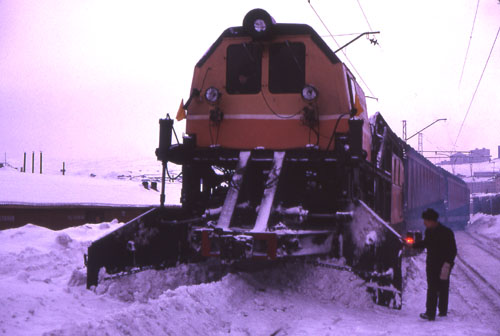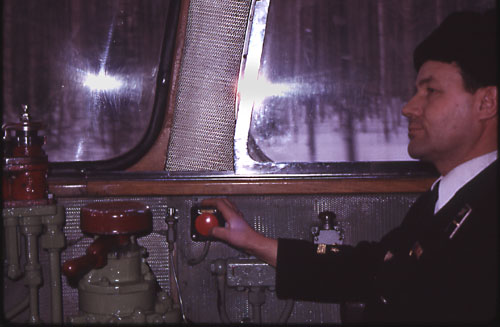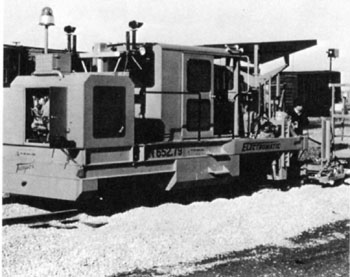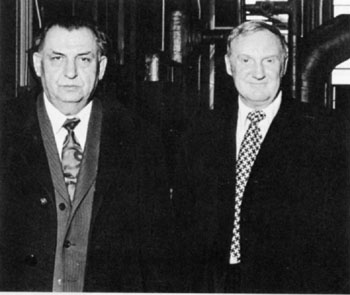|
Six Railwaymen in Search of the Russian
Winter
Canada and the Soviet Union have one thing in common;
a severe winter climate with a particularly heavy snowfall and low temperatures.
So it is not surprising that Canadian rail experts working under the terms
of a recently-signed agreement wanted to visit the USSR in winter months
to see that country's rail systems in action.
I was the Ministry of Transport representative who travelled in February to Russia with five specialists from Canadian railways and an interpreter from the Department of the Secretary of State. Our first full day was spent with officials at the Ministry of Railways on briefings on rail operations. That night, after a visit to the never-to-be-forgotten Moscow Circus, we received our first look at the Moscow Metro. Each station in the subway system is decorated in a different manner with an extensive use of marble, which, though expensive, is easy to maintain. Statues and sculpture are everywhere with a decorative chandelier dominating the whole setting. Another thing that strikes one right away is the cleanliness and lack of advertising in the stations. We constantly interrrupted our subway journey to disembark and tour various stations; one built on the lower level of a two-tier bridge spanning the Moscow River and another with a vestibule the size of a football field. During our stay in Leningrad we were fortunate enough to travel on the Metro system there, which is just as impressive as the Moscow system. There was a novel arrangement at one station where passengers stepped through doors similar to those of an elevator, directly to the doors of the train. Drivers would align the train doors with the station doors, so one never really saw the train from the station. The trains in both Moscow and Leningrad reminded me of the Toronto system, although I did not find them as technically advanced. The noise levels were about the same as Toronto, but I could not help noticing the cleanliness again, and both the Moscow and Leningrad systems have a ban on smoking.
That night we got our first experience as passengers on Soviet railways on the overnight express to Leningrad. As departure time approached, six pairs of eyes cast sur-. reptitious glances at the clock and the train left precisely on time to the accompaniment of six silent nods of approval. Our Leningrad arrival was also precise and after breakfast at our hotel we visited a hump classification and passenger car maintenance factory. Our discussions revealed that Canada and the USSR have much in common in rail problems. The next day we journeyed by special train to inspect a high speed track switch that was developed for the advent of high speed trains. On the way back to Leningrad I rode in the cab of the electric locomotive where I discovered that the words are different but the functions are the same. The Russian enginemen are just as intense as their Canadian counterparts. We left by overnight train for Petrozavodsk in Karelia and I awakened to find us travelling through terrain that reminded me very much of northern Ontario. On arrival we inspected a locomotive repair factory notable for its cleanliness and the house plants we saw throughout the factory - a woman's touch even in a heavy workshop. Our next stop was Murmansk which is as far north as Inuvik in Canada. Out came my heavy winter gear, but I discovered the temperature was just below the freezing mark. There was some snow, however, and we saw an interesting demonstration of snow removal equipment. One of the impressive machines gobbles up snow as it moves forward and passes it into cars farther down the train. We left a Canadian flag in the railway museum as a memento after seeing demonstrations of rail wedge plows and a gigantic snow blower which could throw snow over a hundred metres. The journey from Murmansk to Moscow was made in the "Arctic Express", a diesel train which ran at full speed through a snow storm made possible by an efficient signalling system. The locomotive crew was neatly dressed in white shirts, black ties and a smart black uniform-quite a contrast to the Canadian coveralls and peaked cloth hat. The engine compartment was noisy but was so spotless I walked right through it without getting my hands dirty. The driving cab was at the front of the locomotive but the controls and procedure were very similar to our own. After a quick flight to the new city of Novosibirsk on the Ob River in Siberia, we returned to Moscow for more meetings at the Ministry of Railways and then it was time to leave for home.
Transport Canada Staff Magazine, March-April 1974. There was a follow up article to this one in the July-August edition of Transport Canada. The March-April issue of TRANSPORT CANADA carried an article about a recent visit of Canadian railway specialists to observe the operation of the Soviet railways under winter conditions. In March a delegation of Soviet railwaymen paid a return visit to Canada to observe Canadian railways under similar conditions. The leader of the delegation was A.F. Podpaly, Deputy Minister of Railway Transport. He was accompanied by Y.I. Zhitinev, Deputy Chief of the Moscow Railway, K.S. Isayev and V.B. Korsh of the Central Railway Scientific Research Institute in Moscow, and B.E. Lukov, Engineer of the International Communication Department of the Ministry of Railway Transport. The delegation had its first taste of the unpredictability of the Canadian winter when a snowstorm diverted their flight from Montreal to Toronto, causing a very hurried rearrangement of the first part of the visit with Canadian National Railways organizing an excellent program in Toronto on very short notice. From Toronto the group made a brief side trip to Niagara Falls (taking the opportunity of discussing railway problems with the train crew) before taking the CN Turbotrain to Montreal. The rest of the time was spent with Canadian National and CP Rail in Montreal with the exception of a one day visit to Ottawa where the delegation visited the National Research Council. During the visit to Ottawa, Mr. Podpaly met with Deputy Transport Minister O.G. Stoner, and attended a reception in the Chateau Laurier which was hosted by CTC Chairman, Hon. E.J. Benson. Mr. Podpaly kindly consented to prepare an article on his impressions of Canadian railways. Five Russian Railwaymen in Search of the Canadian
Winter
By A.F. Podpaly Deputy Minister of Transport Union of Soviet Socialist Republics During March, 1974, a delegation of Soviet railway
experts came to Canada to examine various aspects of Canadian railway operations.
The railways of our two countries have many problems in common and we feel
that we have much to gain by cooperating, to help to solve some of these
problems.
The conditions under which Canadian railroads operate, especially climatic conditions, are in many aspects similar to those of the Soviet Union. In both countries the railways carry some two-thirds of the total volume of traffic, and they are the main mode of freight transport. It is because of these similarities that a mutual study and exchange of opinion on certain features of current and planned railway operation may be highly beneficial to both countries. We found that the track, terminal structures and equipment are all maintained in good condition. Of particular interest to us were the efforts to increase the strength of the track superstructure by the use of welded rails with reinforced concrete ties. This is very promising and deserves attention. One particular problem common to both Canadian and Soviet railroads is the battle against frost heaves. Canadian experience in the use of salt to combat such heaving is of great interest to us. 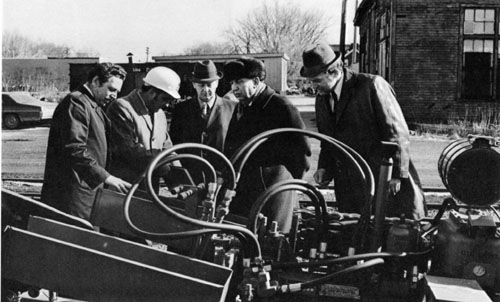
The USSR Deputy Minister of Transport, A.F. Podpaly (second from right) inspects a tie plug inserter at the Canadian National Danforth Shops in Toronto. In the field of snow-clearing technology, I feel that our railways are equipped with more productive equipment such as electrical triple-motor snow blowers and snow removal machines. These machines are very useful in cramped yards because they clear the tracks of snow and transport it to dumps. We were very interested in the new Canadian pneumatic equipment which keeps switch points clear of snow and ice by means of hot and cold air. The work that is going on at the National Research Council's cold weather research laboratory was also very interesting. We were pleased to see the demonstration of track maintenance equipment, especially the tamping, tie-replacing, rail cutting and hole drilling machines but, on the whole, the track maintenance system and the equipment used on the Soviet railways to carry out track maintenance differs significantly from that used in Canada and seems to be more efficient. One of the reasons for this is that many of our lines have a very high freight traffic density and it is necessary to use a complex of highly efficient machines which, within the space of four to five hours, will completely replace a one and a half to two kilometre section of track. Both the Canadian and the Soviet railways are in the process of applying computer technology to railway operation and control, an area in which great improvements in efficiency can be achieved. Canadian railways are well advanced in this field, particularly in the "Tracs" system which employs modern technology and terminal equipment. This system, which operates in real time, makes it possible to develop extensive information on train and car movements and assists greatly in empty car distribution. The results which have so far been obtained on Canadian railroads will assist greatly in the development of an even more extensive use of computer technology in the future automation of railway control systems. The construction of the Toronto hump yard with its well developed track layout will ensure reliable service for some time to come. At the same time, we noticed that cars seem to spend an undue period of time in the yard. In the Soviet Union the car classification yard time is significantly less, and a more efficient use of the car fleet has been achieved as a result of speeding up car turn-arounds. The use of boosters coupled to Canadian yard locomotives was of great interest to us. These improve starting conditions, especially in winter, without the need for either additional or more powerful locomotives. The system of locomotive maintenance differs somewhat between the two countries, particularly in the smaller number of types of maintenance and the increased period between maintenance carried out in Canada. We are now aware of the differences between the two systems and we must now evaluate the advantages and shortcomings of the respective systems. We were particularly interested to see the Canadian National Testing Unit which automatically identifies faults in diesel locomotive electrical systems.
We noted the effective use which is being made of multiple grade oils for rolling stock. These do not require seasonal changes which decrease the cost and simplifies the preparation of locomotives and cars for winter operation. We very much enjoyed our rides on Canadian diesel and turbo trains. The turbo train may turn out to be a promising form of traction for high speed travel on non-electrified lines. In the Soviet Union, however, there is a large network of electrified trackage and most of our attention is directed towards the development of high speed electric trains designed to operate at speeds up to 200 km/hr. On behalf of the Soviet delegation, I would like to express my thanks to the officials of the Ministry of Transport and also the Canadian railways for the opportunity to study winter railway operations, and also for their very kind hospitality. Transport Canada Staff Magazine, July-August 1974. |
